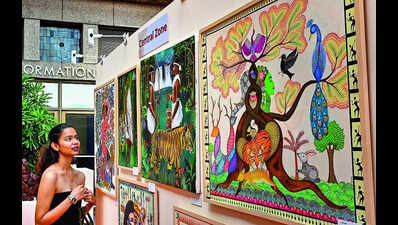Exhibition of paintings by tribal artists depicts what tiger means to communities | Delhi News

NEW DELHI: From a canvas bringing to life the story of Maya -the famed tigress from Tadoba-Andhari Tiger Reserve -to folklore surrounding the tigers of Kaziranga in Assam, Ranthambore in Rajasthan and Kamlang in Arunachal, where communities see the tiger as family, around 250 paintings made by 50 tribal artists living in and around the buffer zones of over 30 tiger reserves are up on display as part of an exhibition “Silent Conversations: From Margins to the Centre’ at the India Habitat Centre in the Capital.From the buffer zones of the tiger reserves where communities thrive amid nature while co-existing with wildlife, these paintings bring into focus the crucial role of communities in conservation efforts and how the tiger is a part of their existence.Cited as a confluence of tribal art, culture and conservation, the exhibition is on till Sunday for Delhiites to experience. It has been organised by non-profit Sankala Foundation, with the support of the National Tiger Conservation Authority (NTCA), a statutory body under the ministry of environment, forest and climate change (MoEFCC), and the International Big Cat Alliance (IBCA).Secretary General NHRC Bharat Lal, who is mentoring this exhibition, sees it as a medium to not just create awareness but also bring alive the oral history of the many tribes that thrive around tiger reserves. The stories have been presented in various art forms, including Gond, Warli, Bhil, Sohrai, Patachitra, Pithora and Lohakam. The exhibition, held like an annual event, is in its fourth year this time.According to the Sankala Foundation team, to encourage the artists -mostly tribals -and support the cause of conservation, these paintings are up for sale, for visitors and organisations to make the tiger and the folklore of communities a part of their homes, offices and life experience.As this correspondent walked past the artwork, 27year-old Maroti Tekam, who hails from Gond tribe in Chandrapur, smiled radiantly, sharing that three of his paintings were on display and showcased stories based on his lived experiences in the Tadoba-Andhari Tiger Reserve in Maharashtra. The one captioned ‘The Love of a Mother in Nature’ is a striking pen picture of the famed tigress Maya, who ruled her territory with grace. “She led her cubs with discipline and knew how to protect her territory. Through my painting I have tried to show her as a symbol of a nurturer, keeping a watchful eye on her cubs while being vigilant to the dangers the jungle presents,” Tekam said.Focussing on co-existence, a 15-year-old artist has highlighted the importance of vultures. Aasawari Aoswale, a class 10 student who lives in Pench Tiger Reserve, shared that her painting depicts how nature creates balance, with vultures being crucial for removal of carcasses of animals that in earlier times were picked up and left on a designated land by villagers.Similar stories abound. Narayan Nayak, an artist from Kaziranga Tiger Reserve, puts out a strong message through his “stripes of resilience” -a painting that shows a crow peeling off the stripes of the tiger and the stripes being removed bearing signs of deforestation, encroachments and other factors leading to a reduction in tiger population. On the other hand, there is also a flower of hope that carries stripes of change: afforestation, conservation efforts, awareness drives and research to protect tiger reserves.The final word, however, came from Sareng Rangmang, a 23-year-old artist from Kamlang Tiger Reserve from Arunachal Pradesh. “We believe the tiger and we humans are like a family and therefore there is no fear. The tiger is our very own and that is what my painting showcases,” she said with a smile.






